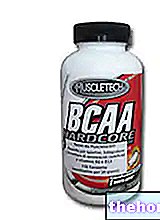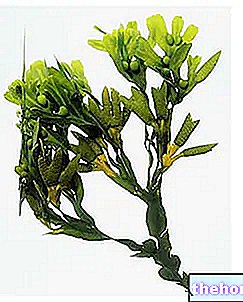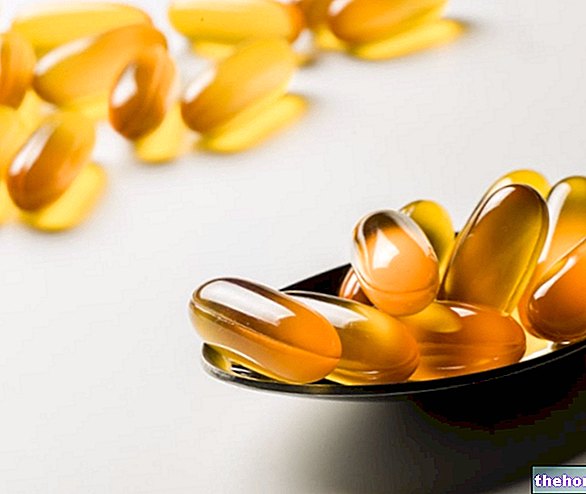What is fenugreek
Fenugreek (Trigonella foenum-graecum) is a plant that grows spontaneously in coastal and submontane environments. Probably native to western Asia, it has a particular odor, repulsive for some, pleasant and characteristic for others. It is no coincidence that the cultivation of this plant is also destined for the perfume industry.

Active principles
The drug consists of its hard, grayish seeds. It is obtained from the fruits which, once fully ripe, are dried in the open air and subjected to beating and husking. Inside there is an alkaloid called trigonellin and responsible, together with the mucilages, for the emollient and expectorant virtues of Trigonella.
The powder obtained from the seeds is usually reddish or gray with yellow tinges. Its nauseating taste is usually corrected with natural flavors such as anise, raspberry or lemon balm. For the same reason, if used during breastfeeding, it gives the milk an unpleasant taste, which could be poorly tolerated by the baby.
Fenugreek as a food
In various parts of the world, fenugreek is also used as a food: in Arab countries it is traditional to enrich dishes intended for engaged girls with its seeds, in order to soften the body shapes and make them more desirable in the eyes of the husband. In India fenugreek is used in curry while in America the oil obtained from the seeds is used in baked goods and ice cream.
Property
Restorative
Fenugreek seed extract boasts restorative and stimulating properties that make it suitable for malnutrition, anemia, infantile frailty, convalescence and breastfeeding (its emmenagogic properties were already known at the time of the ancient Egyptians).
All these properties are linked to the good presence of mineral salts (iron, manganese, copper, magnesium) and vitamins (B6, thiamine and riboflavin), vegetable oils, organic phosphates, fats and proteins. The latter, despite having a fair biological value, are associated with anti-nutritional factors, present in all vegetable protein sources. These are substances that limit the action of digestive enzymes, lowering the nutritional value of the product. Their action is greatly reduced by cooking the foods that contain them.
The good vitamin and mineral balance would also justify its alleged aphrodisiac virtues.
Control of Cholesterol and Glycemia
In literature there are also studies that attribute to the "seed extract hypocholesterolemic and hypotiglyceridemic properties. It has also been shown that fenugreek seeds have the ability to lower blood sugar, modulating the absorption of sugars. Both these characteristics are related to" abundant presence of dehydrated fibers which, once arrived in the intestine, absorb water, increasing intestinal motility and consequently reducing the absorption of nutrients. Furthermore, the stimulatory effect on the excretion of bile acids, which - probably attributable to saponins - facilitates the elimination of excess cholesterol from the body, should also be noted.
Cancer prevention
Finally, the possible positive effect on the prevention of colon and breast cancer (which can always be explained by the abundant presence of fiber) should be noted.
How to use
The normal dose of fenugreek extracts varies from one to three grams of dry extract per day.
Side effects
The low toxicity of fenugreek is evidenced by the results of numerous studies. However, there have been reports of mild intestinal side effects.
On the other hand, it is not recommended during pregnancy, to avoid unwanted increases in uterine contractility, and during breastfeeding, due to the unpleasant taste given to milk.
Select plant Fir Acacia Acerola Sorrel Yarrow Yarrow Yarrow Aconito Adatoda Garlic Agnocasto Agrimonia Alchemilla Alkekengi Aloe Altea Witch Hazel Ammi or Visnaga Pineapple Andrographis Anemone Pulsatilla Angelica Anise Star Anise Japanese Star Anise Bitter Orange Bitter Areca Arnica Harpagophytum Arpagophyte Artemisia Asteragus Basil Asparagus Asparagus Peruvian Asparagus Asparagus Asparagus Hawthorn Boldo Borage Shepherd's Purse Boswellia Bucco Butea superba Cocoa Coffee Cajeput Calamus Calamus Marigold Camedrio Chamomile Roman Chamomile Camphor Cinnamon Ceylon Maidenhair Capuchin Artichoke Cardamom Cardiac Thistle Asian Thistle Carvi Cascara Cassia Catecu Catha Cabbage Celandine Chicory Centaurea Cinnamon Cypress Celandine Chives Cypress Coca Cola Colchico Combreto Condurango Comfrey Coriander Cranberry Barberry American Chrysanthemum Cumin Turmeric Damiana Digital Dioscorea Drosera Dulcamara Dunalilella Echinacea Eder a Ephedra Elenio Eleutherococcus Helichrysum Evening primrose Horsetail Alfalfa Erica Euphrasia Erisimo Escolzia Eucalyptus Farfara Farfaraccio Calabar bean Fenugreek Fennel Phytolacca Frangola Ash Fumaria Japanese Mushrooms Galega Ganoderma lucidum Garcinia Cambogia Mulberry Gentian Broom Ginkgo Ginkgo Guipana Guipana Gynestra Ginkgo Hibelia Gymnasium Hibiscus Guarulp St. John's Wort Horse Chestnut Ispaghul Hyssop Jaborandi Kava kava Konjac Laminaria Cherry Laurel Lavender Lemongrass Lespedeza Lovage Icelandic Lichen Lemon Flax Lippia Licorice Lobelia Hops Maca Marjoram Maize Mallow Manna Marrubio Marrubio d "water Matè Melaleuca Meliloto American Lemon balm Myrtle Myrama Walnut Nutmeg Walnut vomica Olive tree Meadowsweet Ononide Opuntia Oregano Orthosiphon Nettle Poppy Papaya Parietaria Feverfew Passiflora Chilli Perilla Periwinkle Phyllanthus Plantain Picrorhiza Pilosella Pino Pisci dia Podofillo Polygala Grapefruit Parsley Psyllium Pueraria mirifica Butcher's broom Pygeum Quassia Oak Rhubarb Ratania Rauwolfia currant Castor bean Rhodiola Rosehip Rosemary Rue Willow Sarsaparilla Sage Elderberry Sassafras Sedum Ergot Senna Serenoa Repens Soybean Solidago Tansy Taraxus Tamarind Tamarind Tamarind Tamarind Tamarindo Ursina Valerian Vanilla Mullein Verbena Veronica Viburnum Vinca Pansy Mistletoe Vine Withania Yohimbe Saffron Ginger Pumpkin Select disease Juvenile Acne Rosacea Tinnitus Tinnitus Aerophagia Tendon Affections Afonia Aphthae Algias Functional Halitosis Breastfeeding Allergy Anemia Anguish Anxiety Arteriosclerosis Asthrosis Asthrosis Arthritis Arthritis Men Sex Woman Blepharitis and Conjunctivitis Eye bags Bronchitis Gallstones Kidney stones Salivary stones Baldness Androgenetic Candida Fragile hair Caries Headache Cellulitis Motion sickness Cystitis C limaterio Cholecystopathy High cholesterol Ulcerative colitis Colonoscopy Contusions Hematoma Convalescence Couperose Depression Dermatitis Diaper dermatitis Diabetes Diarrhea Erectile dysfunction Dyslipidemia Dysmenorrhea Dyspepsia Disturbances of vision Hemorrhoids Epistaxis Herethism Heart disease Fever Fibromyalgia Gastro-intestinal disease Flatulence Hypertension Fibromyalgia Gastrointomnia Jaundice Laryngitis Renal lithiasis Toothache Sore throat Thinness Menopause Meteorism Mononucleosis Alzheimer's disease Crohn's disease Nausea Vomiting Obesity Dark circles Onychomycosis Osteoporosis Dry skin Periarthritis Piorea Low pressure Prostatitis Psoriasis Colds Breast fissures Anal fissures Gastro-nasal rhinitis Senescence Premenstrual Syndrome Sinusitis Quit smoking Overweight Fatty liver Constipation Stomatitis Stress Cough Triglycerides high Ulcer Burns Nails Brittle flashes Heat Warts Dizziness Properties herbal Tanning Abortive adaptogenic Aphrodisiac bittering analgesic anesthetic anorectics analgesic antacid anti-allergic anti-asthmatic Antibiotic catarrh Anticellulitiche anticonvulsant Antidiaforetiche antidiarrheal edematous anthelmintic antiemetic Antiemorroidarie antiphlogistic Antiidrotiche Antinevrotiche Antioxidants antipyretic antirheumatic antiscorbutic Antiseptic antispasmodic anti-uric Aperitive Flavoring Astringent Balsamic Bechiche Capillarotrope Cardiotonic Carminative Cathartic Caustics Healing Cholagogues Choleretic Dyes Decongestants Deodorants Purifying Diaphoretic Cleansers Disinfectants Detoxifiers Thirst quenching Diuretics Exciting Emetics Emmenagogues Emollients Hemostatic Energies Hepatoprotectors Expectorants Eupepticus Moisturisers Galactosensitizers lanti Hypertensive Hypnotic Hypoglycemic Hypotensive Irritants Laxatives Soothing Narcotic Nerves Nutrients Odontalgic Pectoral Purgative Revulsive Remineralizing Refreshing Rubefacient Scialagoghe Sedative Soporifugas Sneezing Stomachic Stomatics Narcotic Vascular Tightenitis




























